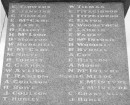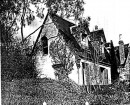PETER AH SEN SAW MILL
SPLITTERS RANGE ROAD OMEO AND TONGIO, EAST GIPPSLAND SHIRE
-
Add to tour
You must log in to do that.
-
Share
-
Shortlist place
You must log in to do that.
- Download report



Statement of Significance
What is significant?
Peter Ah Sen's Sawmill was among the first mills to be established in the Omeo district, and the only known sawmill in Victoria to have been licensed to a Chinese-born person. The site is also the only example known in Victoria of a sawmill powered by an overshot water wheel which has significant remains. Peter Ah Sen operated the mill between 1881 and 1886. The site includes a dam on Gap Creek and a simple earthen channel to deliver water to the mill. The pit for the water wheel is nine metres long and three metres deep, with a tail race connecting the wheel pit with the creek. Stone chimney mounds represent the remains of three dwellings on the site.
How is it significant
Peter Ah Sen's Sawmill is of historical and archaeological significance to the State of Victoria.
Why is it significant?
Peter Ah Sen's Sawmill is historically significant as the first and only sawmill site licensed to a Chinese-born person in Victoria. Peter Ah Sen was born in China around 1827. He emigrated to Australia at an unknown date and was among the first Chinese to arrive in Omeo. Ah Sen achieved success as a gold miner, hotel-keeper, sawmiller and storekeeper, and was headman in his local community. The site has the potential to provide significant information about the Chinese in the Omeo district in particular and in Victoria more generally.
Peter Ah Sen's Sawmill is archaeologically important for its potential to yield evidence about the technological history of sawmilling, and the cultural history of Chinese workers at a forest settlement.
-
-
PETER AH SEN SAW MILL - History
A sawmill site was surveyed for Elizabeth McQueen in 1880, a mill which may have been the earliest in the Omeo district. The surveyor’s plan showed a race and flume, the site for a proposed dam, a site for a water wheel and a T-shaped mill building. McQueen held the site for less than a year, before transferring her interest to Peter Ah Sen in 1881. The site thus became the first and only sawmill licensed to a Chinese-born person in Victoria.
Peter Ah Sen was born in China around 1827. He emigrated to Australia at an unknown date and was among the first Chinese to arrive in Omeo. Also known as Ah Sin, he occupied the position of headman in his local community. By 1873 he was mining at Omeo and Swifts Creek in company with Ah Fook, Cong Jon, Ah Pow and Ah Foo. In addition, he held a licence for a hotel in Omeo in the 1870s. His success in these ventures enabled him to purchase Elizabeth McQueen’s sawmill.
Ah Sen operated the mill for almost five years before selling the business to William Condon, a farmer from Hinnomunjie, in January 1886. Condon immediately shifted the mill further up Gap Creek. Following the sale Peter Ah Sen became a storekeeper at Omeo, where he lived out the remainder of his life. He died in 1893 at the age of sixty-six.
PETER AH SEN SAW MILL - Permit Exemptions
General Exemptions:General exemptions apply to all places and objects included in the Victorian Heritage Register (VHR). General exemptions have been designed to allow everyday activities, maintenance and changes to your property, which don’t harm its cultural heritage significance, to proceed without the need to obtain approvals under the Heritage Act 2017.Places of worship: In some circumstances, you can alter a place of worship to accommodate religious practices without a permit, but you must notify the Executive Director of Heritage Victoria before you start the works or activities at least 20 business days before the works or activities are to commence.Subdivision/consolidation: Permit exemptions exist for some subdivisions and consolidations. If the subdivision or consolidation is in accordance with a planning permit granted under Part 4 of the Planning and Environment Act 1987 and the application for the planning permit was referred to the Executive Director of Heritage Victoria as a determining referral authority, a permit is not required.Specific exemptions may also apply to your registered place or object. If applicable, these are listed below. Specific exemptions are tailored to the conservation and management needs of an individual registered place or object and set out works and activities that are exempt from the requirements of a permit. Specific exemptions prevail if they conflict with general exemptions. Find out more about heritage permit exemptions here.Specific Exemptions:General Conditions: 1. All exempted alterations are to be planned and carried out in a manner which prevents damage to the fabric of the registered place or object. General Conditions: 2. Should it become apparent during further inspection or the carrying out of alterations that original or previously hidden or inaccessible details of the place or object are revealed which relate to the significance of the place or object, then the exemption covering such alteration shall cease and the Executive Director shall be notified as soon as possible. General Conditions: 3. If there is a conservation policy and plan approved by the Executive Director, all works shall be in accordance with it. General Conditions: 4. Nothing in this declaration prevents the Executive Director from amending or rescinding all or any of the permit exemptions. General Conditions: 5. Nothing in this declaration exempts owners or their agents from the responsibility to seek relevant planning or building permits from the responsible authority where applicable.EXEMPTIONS:
Preliminary Mineral Exploration work
Fire suppression duties
Weed and vermin control
Public safety
Rehabilitation, protective and stabilisation works
Information signage - for interpretation and prevention of public risk
-
-
-
-
-
PETER AH SEN SAW MILL
 Victorian Heritage Register H2021
Victorian Heritage Register H2021 -
PETER AH SEN SAWMILL
 Victorian Heritage Inventory
Victorian Heritage Inventory
-
'ELAINE'
 Boroondara City
Boroondara City -
-oonah
 Yarra City
Yarra City -
..eld House
 Yarra City
Yarra City
-
-










